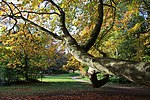Weeting
AC with 0 elementsBreckland DistrictUse British English from October 2018Villages in Norfolk

Weeting is a village in Norfolk, England. The population can be found in the civil parish of Weeting-with-Broomhill. The villages name means 'wet place'.
Excerpt from the Wikipedia article Weeting (License: CC BY-SA 3.0, Authors, Images).Weeting
Lynn Road, Breckland District Weeting-with-Broomhill
Geographical coordinates (GPS) Address Nearby Places Show on map
Geographical coordinates (GPS)
| Latitude | Longitude |
|---|---|
| N 52.466666666667 ° | E 0.61166666666667 ° |
Address
Weeting Bowls Club
Lynn Road
IP27 0QS Breckland District, Weeting-with-Broomhill
England, United Kingdom
Open on Google Maps











